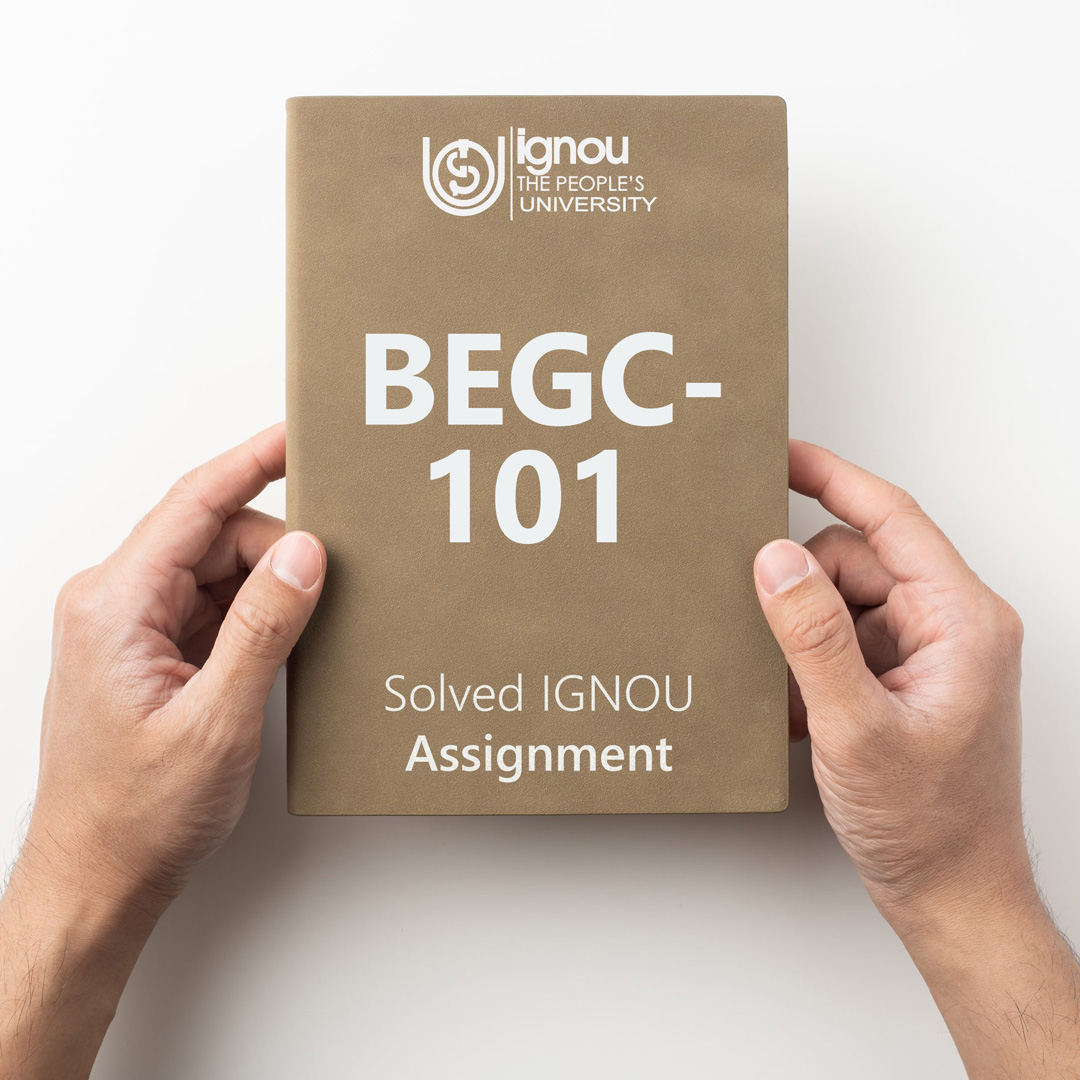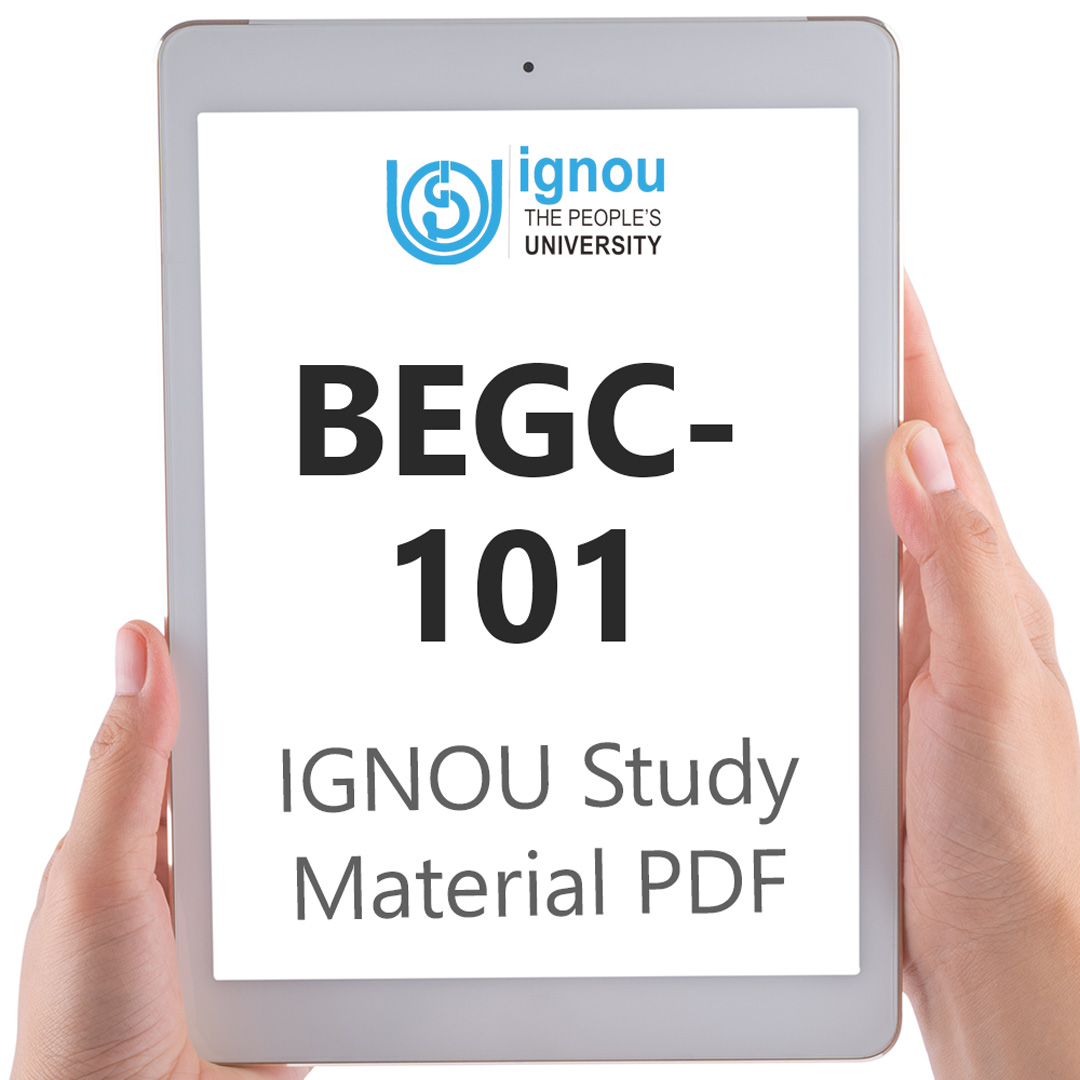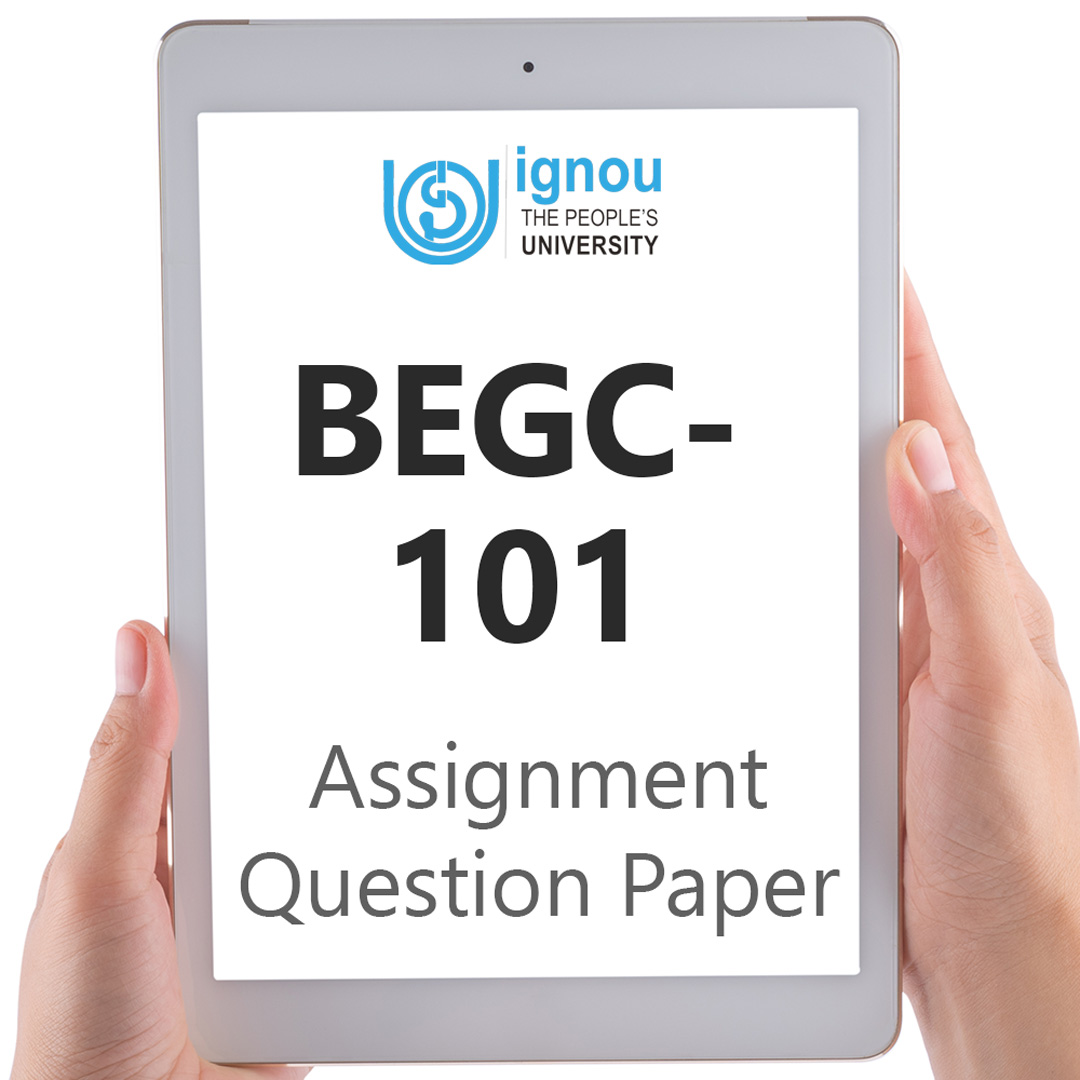If you are looking for BEGC-101 IGNOU Solved Assignment solution for the subject Indian Classical Literature, you have come to the right place. BEGC-101 solution on this page applies to 2022-23 session students studying in BAEGH courses of IGNOU.
BEGC-101 Solved Assignment Solution by Gyaniversity
Assignment Code: BEGC-101/2022-23
Course Code: BEGC 101
Assignment Name: Indian Classical Literature
Year: 2022-2023
Verification Status: Verified by Professor
Max. Marks: 100
Answer all questions.
Section A
Write short notes/ answer with reference to the context in about 100 words each: 4 × 5 = 20
Q1. (i) The purpose of Dramatic Art
Ans) Dramatic art was the most appealing kind of art in ancient India. Lyrical and narrative forms, poetry and prose, speech, singing, and acting, as well as masks, costumes, and ornaments, were all a part of this art form. The popular and folk customs were heavily incorporated into performances during festivals during the ancient times. Even court dramas, which gradually developed over the next centuries, employed these popular forms that were related to common life. Court play incorporated concepts from the four Vedas to elevate its intellectual status. Drama is intended to entertain the audience while also being instructional in nature. In the eyes of critics and authors of Sanskrit literature, the primary goals of dramatic art became to instruct and to amuse.
Q1. (ii) The Sanskrit Epic Tradition
Ans) Because death is not the end in Hindu cosmology, but rather a way to either gain spiritual emancipation from the cycle of life or to keep reincarnating until it is, Sanskrit play does not have a tragic conclusion. Additionally, a crucial component of Sanskrit drama is the Rasa, or aesthetic sentiment, which is best described as the audience's sophisticated emotional reaction to the performance. The fact that Sanskrit drama is bilingual is one of its distinctive features. Characters from different societal groups, such as soldiers, servants, women, and children, etc., talked in the numerous Prakrit languages, in contrast to the Sanskrit spoken by the heroes, who belonged to the upper castes such as Brahmins and Kshatriyas. Sanskrit drama could be performed by men alone, women alone, or a combination of the two, depending on the plot, and there were no restrictions requiring male actors to play the roles of female protagonists.
Q1. (iii) “Now I see no other course open but the fourth – punishment. The kings are marching to Kurukshetra to their doom!”
Ans) In Upaplavya, where the Panadavas are encamped, Krsna returns and consults with Yudhishthira. Krsna informs Yudhishthira of what he observes in Duryodhana's court at the latter's request. He begins by recounting Bhisma's lengthy speech before moving on to Drona's persuasive defence of kingship and warfare. The speeches of Vidura, Gandhari, and Dhrtarastra are then delivered. All of them recount the clan's history in order to convince Duryodhana that the Pandavas deserve the kingdom and that starting a war would be disastrous. When Duryodhana eventually returned, he suggested that the war was unavoidable and that preparations for it should start. Krsna tells Yudhishthira that Duryodhana remained determined and that's why he did as Krsna claims - Now I see no other course open but the fourth—punishment. The kings are marching to Kurukshetra to their doom!
Q1. (iv) ... “And from that exalted line/ Of heavenly nymphs was Matavi descended./ A woman of flawlwss birth, of broad shoulders,/ And curly hair, spilling pollen, she was/ Noted for her style of great distinction.”
Ans) The "Book of Pukar" contains the character Matavi. At the Chozha court, she is referred to as an adept dancer. Matavi was descending the heavenly nymphs' elevated line. She was a perfect woman with lovely features and wide shoulders. Her naturally curly hair was dispersed across her head like a cloud of pollen. She was regarded as a distinguished and stylish woman. Everyone would be enamoured by her attractiveness due to the way she seemed. Up until Kovalan met the stunning and talented dancer Matavi, Kovalan and Kannaki enjoyed the ideal marriage and relationship. He departs from the upset Kannaki for Matavi after becoming mesmerised by the dancer's elegance, melody, and beauty.
Section B
Answer the following in about 350 words each: 4 X 20 = 80
Q1. Examine the difference between the Shakuntala in Abhijnana Shakuntala and the Shakuntala episode in the Mahabharata.
Ans) Shakuntala is the main character of Kalidasa's play Abhijnana Shakuntalam, and the playwright goes into considerable length to describe her emotions and ideas. She struggles and battles throughout the play. For the time being, suffice it to note that Kalidasa drastically alters the Shakuntala storey, both in terms of the text's emphasis and its mode of depiction. Shakuntala is described by Kalidasa in terms of classic feminine beauty, such as having a slim waist, smooth skin, dark hair, etc., but he also adds sensual connotations by using imagery taken from the natural world. The lines of Duhsanta in particular paint a passionate bodily picture of the protagonist. She is compared to beautiful flowers that are blooming with enchanted youth, have doe-like eyes that exude beauty, sensual lips, rounded breasts, etc. Shakuntala is a young girl in Kalidasa's play and has not yet encountered the hardships of the material world.
The Shakuntala part of the Mahabharata is found under the heading "The Origins." Even though Shakuntala is the section's name in the Mahabharata, Shakuntala is highlighted as the lovely maiden and eventually as Bharata's mother. As a result, the monarch occupies a central position and acts as the episode's active agent. The Shakuntala from the epic and the one from the play are slightly different. In the epic, Shakuntala shows up before the court with her kid. When she is turned down, she defends herself and her kid by citing the Law in opposition to Duhsanta's fabrications and epithets. She makes her argument in front of Duhsanta and then gets ready to go. She says her kid will be king. Shakuntala's statements are confirmed by a celestial voice, and the King accepts her. The drama originally diverges by depicting Shakuntala as arriving prior to the son's birth. Shakuntala does, like her epic counterpart, proclaim her veracity in the face of Duhsanta's criticisms, but there is no celestial voice to support her claims, and both Duhsanta and her monastic companions reject her. Shakuntala's status as a pious woman is elevated by the rejection because despite being humiliated in front of everyone, she stays true to her husband and endures her suffering with grace rather than continuing to fight for her rights.
Q2. Write a critical note on the predicament of Karna in the Mahabharata.
Ans) Karna was in a difficult situation at the moment of his decision-making when he had to decide between the law (dharma) and his responsibility; between his mother and his friend. Karna had a difficult time at that time since he was unable to fulfil his mother's wishes without betraying his obligation to his friend and, conversely, he was unable to uphold his friendship without betraying his mother's wishes.
Both Krishna and Kunti met Karna just before the Battle of Kurukshetra broke out, telling him the truth about his birth and pleading with him to join the Pandavas. Karna discovered his actual lineage from Lord Krishna for the first time, discovering that Kunteya, not Radheya, and the five Pandavas are his brothers. Karna was momentarily surprised upon hearing this and was unsure of how to handle the upsetting circumstance. He found himself in a predicament due to his obligations as a friend and a son after becoming so powerless.
If he decided to support the Pandavas, Lord Krishna even promised him Draupadi's company: "And in the sixth turn you shall lay with Draupadi." Karna was not deterred by Lord Krishna's temptations, so Kunti came to visit him and identified herself as his mother. When Kunti forced the Deity Sun to come to her and bear her a son, she simply floated the new-born baby on the River Ganga without giving the child a second thought. Kunti was so cruel and self-centred that she invoked the Deity Sun without considering the terrible consequences of her childish behaviour. It is clear from this that Kunti attempted to emotionally entrap Karna.
For the first time, Kunti requested Karna for a favour, and Karna is renowned for his kindness. Nobody left his door empty-handed, and Kunti was even his mother. However, Karna would have to lie to Duryodhana, who had always stood by him when he was in need, if he followed his mother's orders. He could not, however, perform both of his jobs at once. In order to fulfil his obligation to the other, he had to transgress the first.
Thus, it is evident that Karna is struggling with how to balance his duties as a faithful friend and a brother. Karna is really necessary to Duryodhana right now, and it would be disrespectful to his relationship if he joined the Pandavas and abandoned Duryodhana. A friend in need is truly a friend, after all. Karna also understood, though, that he could not shirk his obligations as a brother and a son. He has a responsibility to defend his brother and to obey his mother because he is the oldest of all the Pandavas. Karna finally decides to put dharma before duty. Even though Duryodhana is an embodiment of wickedness and lawlessness, it is his one and only duty to stand with him.
Q3. Discuss the significance of the storm in Mrichchhkatika?
Ans) Charudatta faces the scene of forming clouds in the Fifth Act in poetic language. The same could be taking place in his head, where all that has been growing there is his love for Vasantasena. Vasantasena, a courtesan, is elevated by her lover. The argument against her, who is referred to as a "harlot" by society, is made quite dramatically, though. After observing that she isn't paying attention to him while he offers her the ornament supplied by Charudatta, Vidushak/Maitreya addresses her in this way.
The entire Storm Scene in Act 5 of The Mrichachhatika has been framed as the ideal chance, which the author, in my opinion, very well seized by revelling in his verbal beauty. He carefully picked this situation since it had lots of room for metaphors and examples. The difference between humanity and how it is reflected in the fundamental nature of the Earth itself is very well shown in this scenario. The Fifth Act is marked by the gathering of dark clouds and the storm, which is increasingly significant. It is shown as a mirror through which the lovers' affection for one another can be seen.
On stage, in particular, it may be coupled with music, actors' actions, and the scene of trees falling and leaves flying around to capture the majesty of the storm. The playwright's focus on the storm serves as a metaphor for the similarity between nature and people. We do not overlook the fact that the storm serves as a visual representation of a natural phenomena, which is fundamentally a human endeavour. This is how nature is influenced by human imagination. However, only the human mind registers the effects of nature (the picture of the storm is constructed because such a thing as the storm exists outside the human subject).
Regardless of how the human mind shapes the storm, it has existed as an objective reality. The argument is that people and the natural world—including the wind, vegetation, sounds, and the hardness and softness of objects—coexist and have an impact on one another. The storm is a major event in the playwright Sudraka's life, and it awakens both him and the audience to the might and beauty of nature. This merits noting and should also be praised. Aesthetic feelings that demand clarity and influence people to take part in movements outside of themselves are also sparked by the storm.
Q4. Write a detailed note on the idea of justice in Cilappatikaran.
Ans) In addition to its role as a ritual epic in Tamil Nadu, the Cilappatikaran is notable for its portrayal of justice in the earliest periods of Indian history. The epic's legendary elements are woven around a twisted notion of justice. Early works like the Arthashastra, which highlight early elements of Maurayan authority and the concept of a King administering it with intricate consequences for crime, show how justice was practised in early India. The character of the verdict is entwined with the notion of a king as a heavenly figure dispensing justice. In order to prevent a miscarriage of justice, the king had to be impartial.
Since the idea of monarchy predominated in early Indian society, which is what the epic is about, the concept of justice is founded on the body of the king, who is divinely chosen and endowed with the capacity to dispense justice. The Dharma is crucial for enforcing justice; hence the King must be a "just and fair King" who upholds it. In the Jain and Buddhist traditions, Dharma governs the entire universe, and any deviation from this would undoubtedly cause a natural disaster. Numerous national literatures and numerous cultures have observed this physical disruption of space. The city of Maturai burns as a result of the Pandyan King's miscarriage of justice.
The Pandyan king erred by failing to investigate the evidence in the case of Kovalan. He created the issue of the violation of the Dharma by ordering his execution on the grounds that he was a thief, and as a result, he must pay a price. According to ancient literature, breaking the law has far-reaching repercussions that touch many people in addition to the offender. This is made clear in early Sanskrit epics like the Mahabharata, when Drtharashtra makes a single mistake by failing to divide the kingdom between the Kauravas and the Pandavas, which causes the Mahabharata war and a massive loss of life. We will discuss how the city of Maturai ends up being destroyed, then how it is revived and rises once again in the following section.






